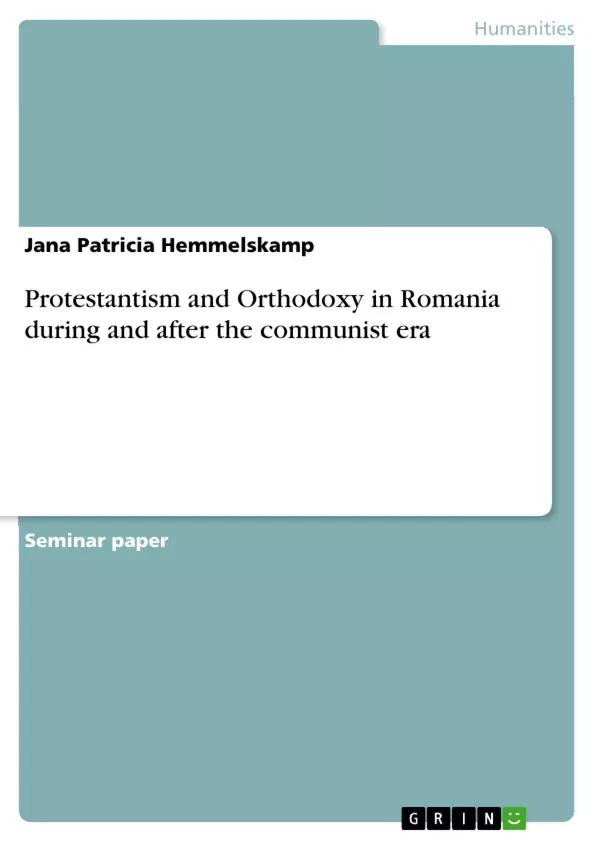Not only historically speaking but also from a religious point of view the communist era is an interesting and highly influential period of time for Eastern Europe and the rest of the world. This age has significantly changed the relationship between church and state in Eastern Europe and Russia from a balanced condition to a rather hostile and combating relation. The reason for this is not only the unconditional adoption of the Marxist ideal of atheism, but primarily a struggle of powers. In the communist era, Religion was perceived as a disturbing factor regarding the political system and the communist government felt questioned and weakened by the influence and authority of the ecclesial institution. Hence, one of the main aims was to weaken and minimize the churches’ impact on society.
However, there are two questions that arise within the analysis of the relationship between church and state during the communist era. The first question is culturally related and queries the equality of the relation in every Eastern European country and Russia. However, since it would be far too complex to answer the inquiry whether every Eastern European government treated the churches the same way or at least similarly, in this essay I am going to focus on a specific Eastern European country. Hence, I am going to analyze the situation in a country which is especially exemplary for the effects of the communist regime, namely Romania. The second question related to this analysis is whether the relationship between state and church can be defined holistically by referring to the term “church” in general. Was the relationship between the state and the Romanian Orthodox Church as the national church similar to the relation between the state and smaller churches? Since Sabrina Petra Ramet pointed out, the “[…] Protestant churches were more ‘troublesome’ for the communists than the Orthodox Church or Catholic Church.” . Therefore I consider it most interesting to compare the ecclesial situations of the Orthodox Church and the Protestant churches in Romania during the communist era and under the communist regime.
Inhaltsverzeichnis (Table of Contents)
- Protestantism and Orthodoxy in Romania during and after the communist era
- Orthodoxy in Romania during the communist era
- Protestantism in Romania
- Different forms of Protestantism
- Traditional-historic Protestants during the communist era
- Neo- Protestants during the communist era
- Religion in Romania at the end and after the communist era
Zielsetzung und Themenschwerpunkte (Objectives and Key Themes)
This essay aims to analyze the relationship between church and state in Romania during the communist era. The focus is on comparing the experiences of the Romanian Orthodox Church and Protestant denominations, particularly highlighting the differences in their relationship with the communist government.
- The impact of the communist regime on religious institutions in Romania
- The differing strategies employed by the Romanian Orthodox Church and Protestant groups to navigate the challenges of the communist era
- The role of religious identity in shaping national identity during the communist period
- The complex interplay between religious freedom and political power in a totalitarian state
- The long-term consequences of communist policies on religious life in Romania.
Zusammenfassung der Kapitel (Chapter Summaries)
The first chapter examines the broader historical and religious context of the communist era in Eastern Europe, emphasizing the shift in the relationship between church and state under communist rule. This chapter also introduces the focus of the essay, which is to analyze the situation in Romania.
The second chapter provides a detailed account of the Romanian Orthodox Church's experiences under the communist regime. It explores the church's collaboration with the state, the motivations behind this cooperation, and the consequences of this relationship. The chapter also examines the various forms of suppression and persecution faced by the Orthodox Church during this period.
The third chapter focuses on Protestantism in Romania, examining its different forms and their historical development. This chapter explores the distinct approaches adopted by traditional-historic and neo-Protestant groups in dealing with the communist regime.
Schlüsselwörter (Keywords)
The main keywords and focus topics of this text include the Romanian Orthodox Church, Protestantism, communist regime, religious freedom, state control, persecution, collaboration, national identity, and the legacy of the communist era in Romania. The essay explores the interplay between these concepts through a historical analysis of the Romanian religious landscape during a period of significant political and social upheaval.
- Quote paper
- Jana Patricia Hemmelskamp (Author), 2012, Protestantism and Orthodoxy in Romania during and after the communist era, Munich, GRIN Verlag, https://www.grin.com/document/278549



